Railway Cloud: Management and Orchestration Functionality Designed as Microservices
Abstract
1. Introduction
2. Related Works
3. Railway Cloud Basic Concepts, Management, and Orchestration Services
- Cloud resource management (CRM) services which are responsible for the allocation and delivery of cloud resources and resource management software, i.e., services that orchestrate railway cloud lifecycle processes, e.g., cloud deployment services, cloud infrastructure catalogue services, railway cloud monitoring services, railway cloud provisioning services, etc.
- Cloudified function management (CFM) services which manage the lifecycles of the cloudified railway functions deployed on the railway cloud.
- Railway cloud pre-deployment processing. The RMAO creates a record associated with the new railway cloud in its catalog.
- Railway cloud platform software installation. The RMAO initializes the railway cloud, enabling communication with the RCP.
- Railway cloud registration and initialization. The RMAO initializes and registers the railway cloud and prepares it for installing the cloudified railway functions.
- Railway cloud post-deployment hardware infrastructure scaling. The RMAO powers on and initializes additional railway cloud nodes for an existing railway cloud.
- Railway cloud platforms software update. The RMAO upgrades or downgrades the platform software of an existing railway cloud.
- Functional status query and update. The RMAO queries and updates of the functional status of the railway cloud resources.
- Update of CRM software. The RMAO updates the railway cloud’s CRM service software.
- Update of CFM software. The RMAO updates the railway cloud’s CFM service software.
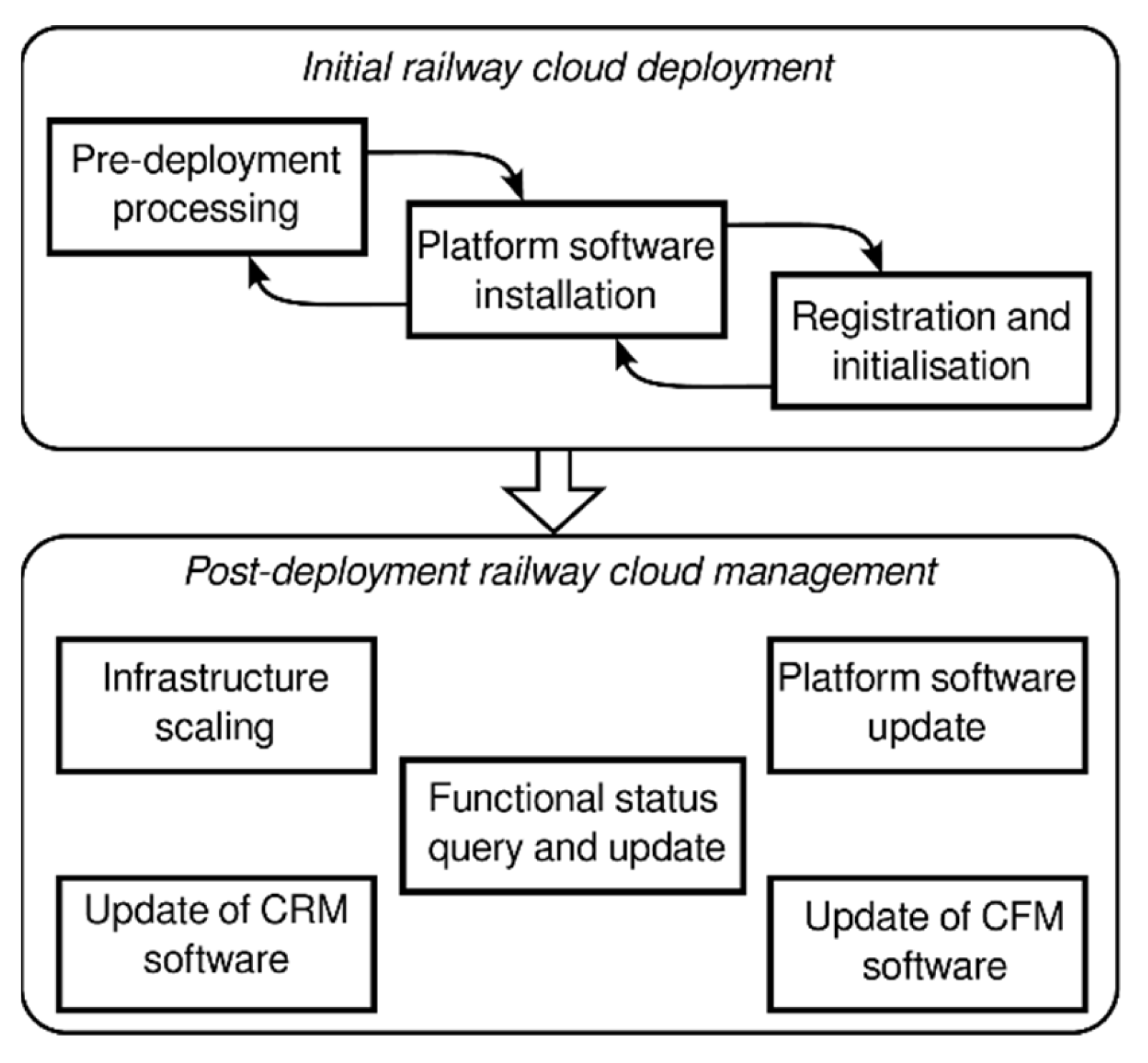
4. Railway Cloud Orchestration Use Cases
- The RMAO needs to assign a unique identifier to a newly deployed railway cloud that will be used for handling the cloud registration process.
- The RMAO needs to load the railway cloud platform software on the first node.
- The CRM services need to load the basic railway cloud software on the other nodes to configure and activate the CFM services and to create/refresh the software catalogue.
- The RMAO needs to be able to query the CRM services about the software catalogue to configure the CFM services, if required, and to register the CFM services in its catalogue.
- The RMAO should be able to update information in the railway cloud catalogue (e.g., resource configurations, capacity, utilisation, etc.) or to add information about a newly installed node.
- The RMAO should be able to scale the railway cloud hardware infrastructure.
- The RMAO should be able to update the railway cloud platform software by triggering the software download and validation procedure.
- The CRM services need to be able to perform pre-checking of the downloaded software to migrate the cloudified railway functions deployed on the affected nodes to other nodes, to update the software images, and to perform a restart if required.
- The RMAO needs to be able to query and update the railway cloud functional status.
- The RMAO needs to be able to update the software of the CRM services and the software of the CFM services, including the triggering of the requested software version’s download, pre-checking, installing, and catalogue update.
- The RMAO needs to notify the railway cloud operator about the result of the orchestration process.
- Instantiation of the cloudified railway functions on the cloud.
- Scaling of the cloudified railway functions.
- Software update of the cloudified railway functions.
- Termination of the cloudified railway functions.
5. Microservices for Railway Cloud Orchestration
5.1. Design of Microservices
5.2. Verification of Microservices
- A software update is triggered, a CFM services’ software image binaries synchronisation takes place, a pre-check of the new CFM services’ software version is triggered: ∀ (sa1 la1 sa2) ∧ ((sa2 la3 sa3) ∧ (sa3 la4 sa4) ∨ (sa2 la2 sa4)) ∃ (sm1 lm1 sm1) ∧ ((sm1 lm2 sm2) ∧ (sm2 lm3 sm2) ∧ (sm2 lm4 sm3) ∨ (sm1 lm4 sm3)).
- The pre-check procedure is successful, and a software uploading is triggered: ∀ (sa4 la6 sa5) ∃ (sm3 lm5 sm4) ∧ (sm4 lm6 sm3) ∧ (sm3 lm7 sm3) ∧(sm3 lm9 sm5).
- The pre-check procedure is unsuccessful: ∀ (sa4 la7 sa7) ∃ (sm3 lm8 sm10).
- The CFM services’ software upload, which includes resource allocation, software installation and testing, is successful: ∀ (sa5 la8 sa6) ∃ (sm5 lm10 sm5) ∧ (sm5 lm11 sm6) ∧ (sm6 lm12 sm6) ∧ (sm6 lm13 sm7) ∧ (sm7 lm14 sm8).
- The CFM services’ software is uploaded, resources are allocated, and the software is installed, but the test procedures fail, and a rollback procedure is executed: ∀ (sa5 la9 sa7) ∃ ((sm5 lm11 sm6) ∧ ((sm6 lm15 sm9) ∨ (sm6 lm16 sm9)) ∧ (sm9 lm17 sm10).
- A software update is triggered, the new software version is available pre-checked, and a resource allocation is triggered: ∀ (sm1 lm1 sm1) ∧ ((sm1 lm2 sm2) ∧ (sm2 lm3 sm2) ∧ (sm2 lm4 sm3) ∨ (sm1 lm4 sm3)) ∧ (sm3 lm9 sm5) ∃ (sn1 ln1 sn2) ∧ (sn2 ln2 sn2).
- The resource allocation is done, the new SW version is installed, and a testing procedure is triggered: ∀ (sm5 lm10 sm5) ∧ (sm5 lm11 sm6) ∃ (sn2 ln3 sn3) ∧ (sn3 ln4 sn3) ∧ (sn3 ln5 sn4).
- The new SW version successfully passes the testing procedure, and it is activated: ∀ (sm6 lm12 sm6) ∧ (sm6 lm13 sm7) ∧ (sm7 lm14 sm8) ∃ (sn4 ln7 sn4) ∧ (sn4 ln8 sn5) ∧ (sn5 ln9 sn6).
- The test of the new SW version fails, and a rollback to the previous SW version is done: ∀ (sm6 lm16 sm9) ∧ (sm9 lm17 sm10) ∃ (sn4 ln7 sn4) ∧ (sn4 ln10 sn7) ∧ (sn7 ln11 sn8).
5.3. Validation of Microservices
6. Railway Cloud Issues Regarding Safety and Security
- Lower investments and reduced operational costs due to the security and compliance framework respected by cloud services providers.
- Improved reliability and availability based on the authorized access to data and centralized security control.
- Flexible cloud security scaling with evolving requirements.
- Improved protection against distributed denial of service via continuous attack monitoring and dispersing.
7. Conclusions
- Identification of the key railway cloud concepts
- Recognition of the general principles of the railway cloud management and orchestration interface
- Description of some of the basic use cases related to the railway cloud orchestration
- Definition of requirements for the railway cloud orchestration
- Synthesis of cloud orchestration functionality as microservices by identification of resources, representing physical or logical objects in the railway cloud orchestration, their structure, applicable methods, and data types
- Verification of microservices by modelling the common orchestration logic of microservices and railway applications
- Validation of microservices by evaluation of latency injected by the microservices API as a key performance indicator for mission-critical applications.
Author Contributions
Funding
Institutional Review Board Statement
Informed Consent Statement
Data Availability Statement
Acknowledgments
Conflicts of Interest
References
- Nikolopoulou, V.; Mandoc, D.; Bazizi, F.; Kloecker, M.; Tardif, S.; Holfeld, B.; Jornod, G.; Salhab, N.; Berbineau, M.; Gogos, S. 5GRAIL paves the way to the Future Railway Mobile Communication System Introduction. In Proceedings of the 2022 IEEE Future Networks World Forum (FNWF), Montreal, QC, Canada, 10–14 October 2022; pp. 53–57. [Google Scholar] [CrossRef]
- Iacurto, C.; Catuogno, T.; Brizzi, A.; Pandolfi, L.; Miglietta, A.; Rokitansky, C.H.; Eschbacher, K.; Pellegrini, V.; Toptsidis, N. Capacity Study for a 5G Satellite System to support Railway FRMCS Critical service over Europe. In Proceedings of the 2022 IEEE 95th Vehicular Technology Conference: (VTC2022-Spring), Helsinki, Finland, 19–22 June 2022; pp. 1–5. [Google Scholar] [CrossRef]
- Tardif, S.; Salhab, N.; Nikolopoulou, V.; Kloecker, M.; Holfeld, B.; Bazizi, F.; Mandoc, D.; Berbineau, M.; Gogos, S. Experimental Trials for the Future Railway Mobile Communication System in 5GRail Project. In Proceedings of the 2023 IEEE 97th Vehicular Technology Conference (VTC2023-Spring), Florence, Italy, 20–23 June 2023; pp. 1–5. [Google Scholar] [CrossRef]
- Bhagat, A.K.; Gandhi, J. A Comprehensive Analysis of 5G Security Core Technologies and Services: Conceptual Frameworks, Challenges, and Solutions. In Proceedings of the 2023 International Conference on Artificial Intelligence and Smart Communication (AISC), Greater Noida, India, 27–29 January 2023; pp. 1273–1281. [Google Scholar] [CrossRef]
- Panda, I.; Ramanath, S. Railways Communication Beyond 5G: Opportunities and Challenges. In Proceedings of the 2023 15th International Conference on COMmunication Systems & NETworkS (COMSNETS), Bangalore, India, 3–8 January 2023; pp. 327–330. [Google Scholar] [CrossRef]
- Phusakulkajorn, W.; Núñez, A.; Wang, H.; Jamshidi, A.; Zoeteman, A.; Ripke, B.; Dollevoet, R.; De Schutter, B.; Li, Z. Artificial intelligence in railway infrastructure: Current research, challenges, and future opportunities. Intell. Transp. Infrastruct. 2023, 2, liad016. [Google Scholar] [CrossRef]
- Li, S.; Wang, J. Review of Network Anomaly Detection in the High-speed Railway Signal System Based on Artificial Intelligence. In Proceedings of the 2023 IEEE 3rd International Conference on Computer Communication and Artificial Intelligence (CCAI), Taiyuan, China, 26–28 May 2023; pp. 318–325. [Google Scholar] [CrossRef]
- Zhang, J.; Zhang, J. Artificial Intelligence Applied on Traffic Planning and Management for Rail Transport: A Review and Perspective. Discret. Dyn. Nat. Soc. 2023, 2023, 1832501. [Google Scholar] [CrossRef]
- Jevinger, Å.; Zhao, C.; Persson, J.A.; Davidsson, P. Artificial intelligence for improving public transport: A mapping study. Public Transp. 2023, 16, 99–158. [Google Scholar] [CrossRef]
- Gore, P.; Dudhe, R.; Raina, R. A review of Renewable Energy & Smart Grid system applications in railways. In Proceedings of the 2023 Advances in Science and Engineering Technology International Conferences (ASET), Dubai, United Arab Emirates, 20–23 February 2023; pp. 1–6. [Google Scholar] [CrossRef]
- De Donato, L.; Dirnfeld, R.; Somma, A.; De Benedictis, A.; Flammini, F.; Marrone, S.; Saman Azari, M.; Vittorini, V. Towards AI-assisted digital twins for smart railways: Preliminary guideline and reference architecture. J. Reliab. Intell. Environ. 2023, 9, 303–317. [Google Scholar] [CrossRef]
- Wu, J.; Wang, X.; Dang, Y.; Lv, Z. Digital twins and artificial intelligence in transportation infrastructure: Classification, application, and future research directions. Comput. Electr. Eng. 2022, 101, 107983. [Google Scholar] [CrossRef]
- Djordjević, B.; Fröidh, O.; Krmac, E. Determinants of autonomous train operation adoption in rail freight: Knowledge-based assessment with Delphi-ANP approach. Soft Comput. 2023, 27, 7051–7069. [Google Scholar] [CrossRef]
- Jansson, E.; Olsson, N.O.; Fröidh, O. Challenges of replacing train drivers in driverless and unattended railway mainline systems—A Swedish case study on delay logs descriptions. Transp. Res. Interdiscip. Perspect. 2023, 21, 100875. [Google Scholar] [CrossRef]
- Daniyan, I.; Mpofu, K.; Muvunzi, R.; Uchegbu, I.D. Implementation of Artificial intelligence for maintenance operation in the rail industry. Procedia CIRP 2022, 109, 449–453. [Google Scholar] [CrossRef]
- Shim, J.; Koo, J.; Park, Y. A Methodology of Condition Monitoring System Utilizing Supervised and Semi-Supervised Learning in Railway. Sensors 2023, 23, 9075. [Google Scholar] [CrossRef]
- Natali, C.D.; Mattila, J.; Kolu, A.; De Vito, P.; Gauttier, S.; Morata, M.; Garcia, M.; Caldwell, D. Smart tools for railway inspection and maintenance work, performance and safety improvement. Transp. Res. Procedia 2023, 72, 3070–3077. [Google Scholar] [CrossRef]
- Pang, Z.; Wang, L.; Wang, S.; Li, L.; Peng, Q. Dynamic train dwell time forecasting: A hybrid approach to address the influence of passenger flow fluctuations. Railw. Eng. Sci. 2023, 31, 351–369. [Google Scholar] [CrossRef]
- Birgillito, G.; Rindone, C.; Vitetta, A. Passenger Mobility in a Discontinuous Space: Modelling Access/Egress to Maritime Barrier in a Case Study. J. Adv. Transp. 2018, 2018, 6518329. [Google Scholar] [CrossRef]
- Dekker, B.; Ton, B.; Meijer, J.; Bouali, N.; Linssen, J.; Ahmed, F. Point Cloud Analysis of Railway Infrastructure: A Systematic Literature Review. IEEE Access 2023, 11, 134355–134373. [Google Scholar] [CrossRef]
- Li, P.; Xue, R.; Shao, S.; Zhu, Y.; Liu, Y. Current state and predicted technological trends in global railway intelligent digital transformation. Railw. Sci. 2023, 2, 397–412. [Google Scholar] [CrossRef]
- Vanichchanunt, P.; Tanmalaporn, T.; Suthamvijit, C.; Noisri, S.; Wuttisittikulkij, L.; Pongyart, W.; Paripurana, S. Virtual Reality for Railway Signaling System Training. In Proceedings of the 2023 20th International Conference on Electrical Engineering/Electronics, Computer, Telecommunications and Information Technology (ECTI-CON), Nakhon Phanom, Thailand, 9–12 May 2023; pp. 1–4. [Google Scholar] [CrossRef]
- Ruscelli, A.L.; Fichera, S.; Paolucci, F.; Giorgetti, A.; Castoldi, P.; Cugini, F. Introducing Network Softwarization in Next-Generation Railway Control Systems. In Proceedings of the 2019 6th International Conference on Models and Technologies for Intelligent Transportation Systems (MT-ITS), Cracow, Poland, 5–7 June 2019; pp. 1–7. [Google Scholar] [CrossRef]
- Pencheva, E.; Atanasov, I.; Trifonov, V. Towards Intelligent, Programmable, and Open Railway Networks. Appl. Sci. 2022, 12, 4062. [Google Scholar] [CrossRef]
- Atanasov, I.; Vatakov, V.; Pencheva, E. A Microservices-Based Approach to Designing an Intelligent Railway Control System Architecture. Symmetry 2023, 15, 1566. [Google Scholar] [CrossRef]
- Li, Y.; Zhu, L. Collaborative Cloud and Edge Computing in 5G based Train Control Systems. In Proceedings of the GLOBECOM 2022—2022 IEEE Global Communications Conference, Rio de Janeiro, Brazil, 4–8 December 2022; pp. 2542–2547. [Google Scholar] [CrossRef]
- Zhang, X. Optimization design of railway logistics center layout based on mobile cloud edge computing. PeerJ Comput. Sci. 2023, 9, e1298. [Google Scholar] [CrossRef]
- Tian, L.; Li, M.; Si, P.; Yang, R.; Sun, Y.; Wang, Z. Design and Optimization in MEC-Based Intelligent Rail System by Integration of Distributed Multi-Hop Communication and Blockchain. Math. Probl. Eng. 2023, 2023, 8858263. [Google Scholar] [CrossRef]
- Haiyan, S.; Tianyun, S.; Jiaying, D.; Guoyuan, Y.; Qingbo, C. Research on Control Mode and Perception Model of Intelligent Railway Station Equipment Based on Edge Computing. In Proceedings of the 2021 IEEE 4th Advanced Information Management, Communicates, Electronic and Automation Control Conference (IMCEC), Chongqing, China, 18–20 June 2021; pp. 2085–2090. [Google Scholar] [CrossRef]
- Aufderheide, H.; Brandes, N. Architecting for Resilience in the Cloud for Critical Railway Systems. AWS for Industries. Available online: https://aws.amazon.com/blogs/industries/architecting-for-resilience-in-the-cloud-for-critical-railway-systems-2 (accessed on 23 January 2024).
- Gala, G.; Fohler, G.; Tummeltshammer, P.; Resch, S.; Hametner, R. RT-Cloud: Virtualization Technologies and Cloud Computing for Railway Use-Case. In Proceedings of the 2021 IEEE 24th International Symposium on Real-Time Distributed Computing (ISORC), Daegu, Republic of Korea, 1–3 June 2021; pp. 105–113. [Google Scholar] [CrossRef]
- Huang, Q.; Yin, W.; An, J.; Zhou, Y. A China Railway Express-Based Model for Designing a Cross-Border Logistics Information Cloud Platform Scheme. Appl. Sci. 2020, 10, 4110. [Google Scholar] [CrossRef]
- He, M.; Li, H.; Duan, Y. Research on Railway Intelligent Operation and Maintenance and Its System Architecture. In Proceedings of the 2019 6th International Conference on Dependable Systems and Their Applications (DSA), Harbin, China, 3–6 January 2020; pp. 488–490. [Google Scholar] [CrossRef]
- Zhu, W. Research on Construction of Cloud Computing Platform for Railway Enterprises. In Proceedings of the 2019 International Conference on Artificial Intelligence and Advanced Manufacturing (AIAM), Dublin, Ireland, 16–18 October 2019; pp. 488–492. [Google Scholar] [CrossRef]
- Yu, S.; Chang, H.; Wang, H. Design of Cloud Computing and Microservice-Based Urban Rail Transit Integrated Supervisory Control System Plus. Urban Rail Transit. 2020, 6, 187–204. [Google Scholar] [CrossRef]
- Yu, S.D. Research on cloud computing in the key technologies of railway intelligent operation and maintenance sharing platform. J. Phys. Conf. Ser. 2021, 1800, 012010. [Google Scholar] [CrossRef]
- Ren, S.; Li, Y. A review of high performance computing applications in high-speed rail systems. High-Speed Railw. 2023, 1, 92–96. [Google Scholar] [CrossRef]
- Zhu, L.; Zhuang, Q.; Jiang, H.; Liang, H.; Gao, X.; Wang, W. Reliability-aware failure recovery for cloud computing based automatic train supervision systems in urban rail transit using deep reinforcement learning. J. Cloud Comput. 2023, 12, 147. [Google Scholar] [CrossRef]
- Wang, Q.; Chai, M.; Wang, H.; Zhang, H.; Chai, J.; Lin, B. Cloud-Based Simulated Automated Testing Platform for Virtual Coupling System. In Proceedings of the 2022 IEEE 25th International Conference on Intelligent Transportation Systems (ITSC), Macau, China, 8–12 October 2022; pp. 2738–2743. [Google Scholar] [CrossRef]
- Rajan, T.K.; Karthick, S.; Nirmal, S.; Kumar, S.N.; Senthilmurugan, S. IoT Based Remote Surveillance For Animal Tracking Near Railway Tracks. In Proceedings of the 2023 International Conference on Networking and Communications (ICNWC), Chennai, India, 5–6 April 2023; pp. 1–7. [Google Scholar] [CrossRef]
- Malekjafarian, A.; Sarrabezolles, C.A.; Khan, M.A.; Golpayegani, F. A Machine-Learning-Based Approach for Railway Track Monitoring Using Acceleration Measured on an In-Service Train. Sensors 2023, 23, 7568. [Google Scholar] [CrossRef] [PubMed]
- Gosiewska, A.; Baran, Z.; Baran, M.; Rutkowski, T. Seeking a Sufficient Data Volume for Railway Infrastructure Component Detection with Computer Vision Models. Sensors 2023, 23, 7776. [Google Scholar] [CrossRef] [PubMed]
- Ping, L.; Pu, W.; Jinzi, Z. Research on Global Optimization Scheduling Method of High-speed Railway Emergency Resource Based on Service Pool. In Proceedings of the 2020 IEEE International Conference on Advances in Electrical Engineering and Computer Applications(AEECA), Dalian, China, 25–27 August 2020; pp. 100–108. [Google Scholar] [CrossRef]
- Nawghare, S.; Somkunwar, R.K.; Shaikh, Z. Indian Railways Smart Ticketing Validation System with Improved Alert Approach. In Proceedings of the 2023 International Conference on Sustainable Computing and Smart Systems (ICSCSS), Coimbatore, India, 14–16 June 2023; pp. 1328–1332. [Google Scholar] [CrossRef]
- Shan, X.; Zhang, Z.; Ning, F.; Li, S.; Dai, L. Application and realization of key technologies in China railway e-ticketing system. Railw. Sci. 2023, 2, 140–156. [Google Scholar] [CrossRef]
- Tao, X.; Zhou, Y.; Mei, Y.; Fujita, H. Parallel simulation of high-speed trains controlled by radio block centers using Spark cloud. Adv. Mech. Eng. 2023, 15, 16878132231186258. [Google Scholar] [CrossRef]
- Xu, L.; Pan, Z.; Liu, H.; Geng, S.; Wan, H. Intelligent Operation and Maintenance Platform for Power Supply System of Urban Rail Transit. In Proceedings of the 5th International Conference on Electrical Engineering and Information Technologies for Rail Transportation (EITRT) 2021, Qingdao, China, 22–24 October 2021; Jia, L., Qin, Y., Liang, J., Liu, Z., Diao, L., An, M., Eds.; Springer: Singapore, 2022; Volume 864, pp. 156–163. [Google Scholar] [CrossRef]
- Zhang, Z.; Li, J.; Sun, Y.; Li, Y.; Song, H.; Dong, H. Blockchain-based Secure Key Management model for High-speed Railway. In Proceedings of the 2022 IEEE 25th International Conference on Intelligent Transportation Systems (ITSC), Macau, China, 8–12 October 2022; pp. 1988–1993. [Google Scholar] [CrossRef]
- Qlu, Y. Secure Mechanism of Intelligent Urban Railway Cloud Platform Based on Zero-trust Security Architecture. In Proceedings of the 6th International Conference on High Performance Compilation, Computing and Communications, Jilin, China, 23–25 June 2022; pp. 99–105. [Google Scholar] [CrossRef]
- Xu, D.; Liu, F.; Chen, W.; He, F.; Tang, X.; Zhang, Y.; Wang, B. A review of research on multi-cloud management platforms. In Proceedings of the Computer Technology and Transportation ISCTT 2022, 7th International Conference on Information Science, Xishuangbanna, China, 27–29 May 2022; pp. 1–16. [Google Scholar]
- Shevtekar, P.S.S.; Kulkarni, S.; Talwara, H. Cost-Effective Resource Allocation and Optimization Strategies for Multi-Cloud Environments. Int. J. Res. Appl. Sci. Eng. Technol. 2023, 11, 602–605. [Google Scholar] [CrossRef]
- Kumar, P.; Garg, A.; Sharmila, R.; Parashar, H.; Khatri, V. SLA Framework and Management under Multi-Cloud Infrastructure. In Proceedings of the 2022 2nd International Conference on Innovative Sustainable Computational Technologies (CISCT), Dehradun, India, 23–24 December 2022; pp. 1–5. [Google Scholar] [CrossRef]
- Toutova, N.V.; Erokhin, A.G.; Toutov, A.V.; Vanina, M.F.; Frolova, E.A. Principals of Optimal Cloud Resource Management. In Proceedings of the 2022 Intelligent Technologies and Electronic Devices in Vehicle and Road Transport Complex (TIRVED), Moscow, Russia, 10–11 November 2022; pp. 1–7. [Google Scholar] [CrossRef]
- Manchanda, A.; Kaur, A.; Kaur, A. Cloud Computing: Resource Management, Categorization, Scalability and Taxonomy. In Proceedings of the 2023 2nd Edition of IEEE Delhi Section Flagship Conference (DELCON), Rajpura, India, 24–26 February 2023; pp. 1–5. [Google Scholar] [CrossRef]
- Yezdani, R.; Quadri, S.M.K. Power and Performance Issues and Management Approaches in Cloud Computing. In Proceedings of the 2022 4th International Conference on Advances in Computing, Communication Control and Networking (ICAC3N), Greater Noida, India, 16–17 December 2022; pp. 2112–2120. [Google Scholar] [CrossRef]
- Zhou, H. A Novel Approach to Cloud Resource Management: Hybrid Machine Learning and Task Scheduling. J. Grid Comput. 2023, 21, 68. [Google Scholar] [CrossRef]
- Chen, Q.; Wang, X.; Jiang, Z. Efficient Cloud Computing Resource Management Strategy Based on Auction Mechanism. In Proceedings of the 2023 24th Asia-Pacific Network Operations and Management Symposium (APNOMS), Sejong, Republic of Korea, 6–8 September 2023; pp. 286–289, ISSN 2576-8565. [Google Scholar]
- Hasan, M.Z.; Sarwar, N.; Alam, I.; Hussain, M.Z.; Siddiqui, A.A.; Irshad, A. Data Recovery and Backup management: A Cloud Computing Impact. In Proceedings of the 2023 IEEE International Conference on Emerging Trends in Engineering, Sciences and Technology (ICES&T), Bahawalpur, Pakistan, 9–11 January 2023; pp. 1–6. [Google Scholar] [CrossRef]
- Kaur, M.; Kaimal, A.B. Analysis of Cloud Computing Security Challenges and Threats for Resolving Data Breach Issues. In Proceedings of the 2023 International Conference on Computer Communication and Informatics (ICCCI), Coimbatore, India, 23–25 January 2023; pp. 1–6. [Google Scholar] [CrossRef]
- Bhattacharyya, L.; Purohit, S.G.; Fatmawati, E.; Sunil, D.M.; Toktakynovna, Z.; Sriramakrishnan, G. Cloud Computing for Suitable Data Management and Security within Organisations. In Proceedings of the 2022 3rd International Conference on Smart Electronics and Communication (ICOSEC), Trichy, India, 20–22 October 2022; pp. 912–916. [Google Scholar] [CrossRef]
- Sawhney, G.; Kaur, G.; Deorari, R. CSPM: A Secure Cloud Computing Performance Management Model. In Proceedings of the 2022 International Conference on Cyber Resilience (ICCR), Dubai, United Arab Emirates, 6–7 October 2022; pp. 1–5. [Google Scholar] [CrossRef]
- Zhou, Q.; Ou, W.; Zheng, W. Research on Cloud Computing Security Technology under Computer Big Data Network. In Proceedings of the 2023 IEEE 3rd International Conference on Electronic Technology, Communication and Information (ICETCI), Changchun, China, 26–28 May 2023; pp. 1686–1691. [Google Scholar] [CrossRef]
- Rindone, C. Sustainable Mobility as a Service: Supply Analysis and Test Cases. Information 2022, 13, 351. [Google Scholar] [CrossRef]
- Van Der Schaft, A. Bisimulation of Dynamical Systems. In Hybrid Systems: Computation and Control; Goos, G., Hartmanis, J., Van Leeuwen, J., Alur, R., Pappas, G.J., Eds.; Springer: Berlin/Heidelberg, Germany, 2004; Volume 2993, pp. 555–569. [Google Scholar] [CrossRef]
- Bian, G.; Abate, A. On the Relationship Between Bisimulation and Trace Equivalence in an Approximate Probabilistic Context. In Foundations of Software Science and Computation Structures; Esparza, J., Murawski, A.S., Eds.; Springer: Berlin/Heidelberg, Germany, 2017; Volume 10203, pp. 321–337. [Google Scholar] [CrossRef]
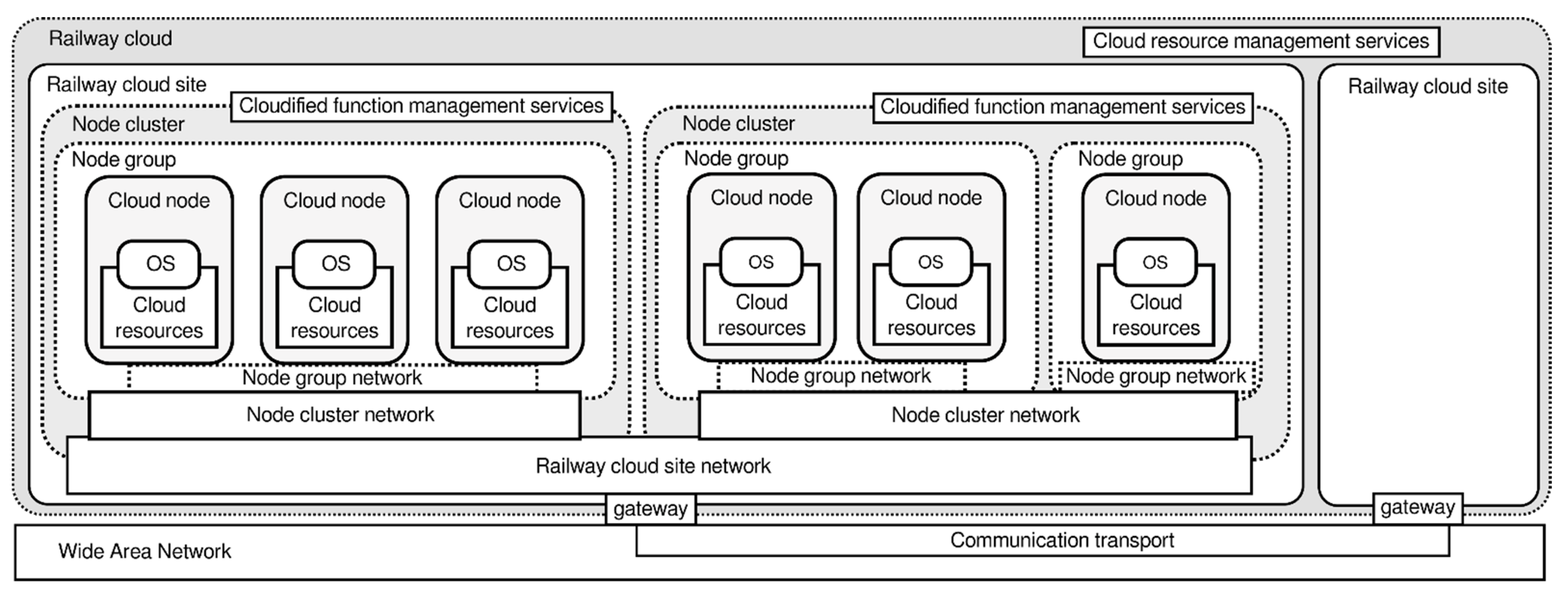
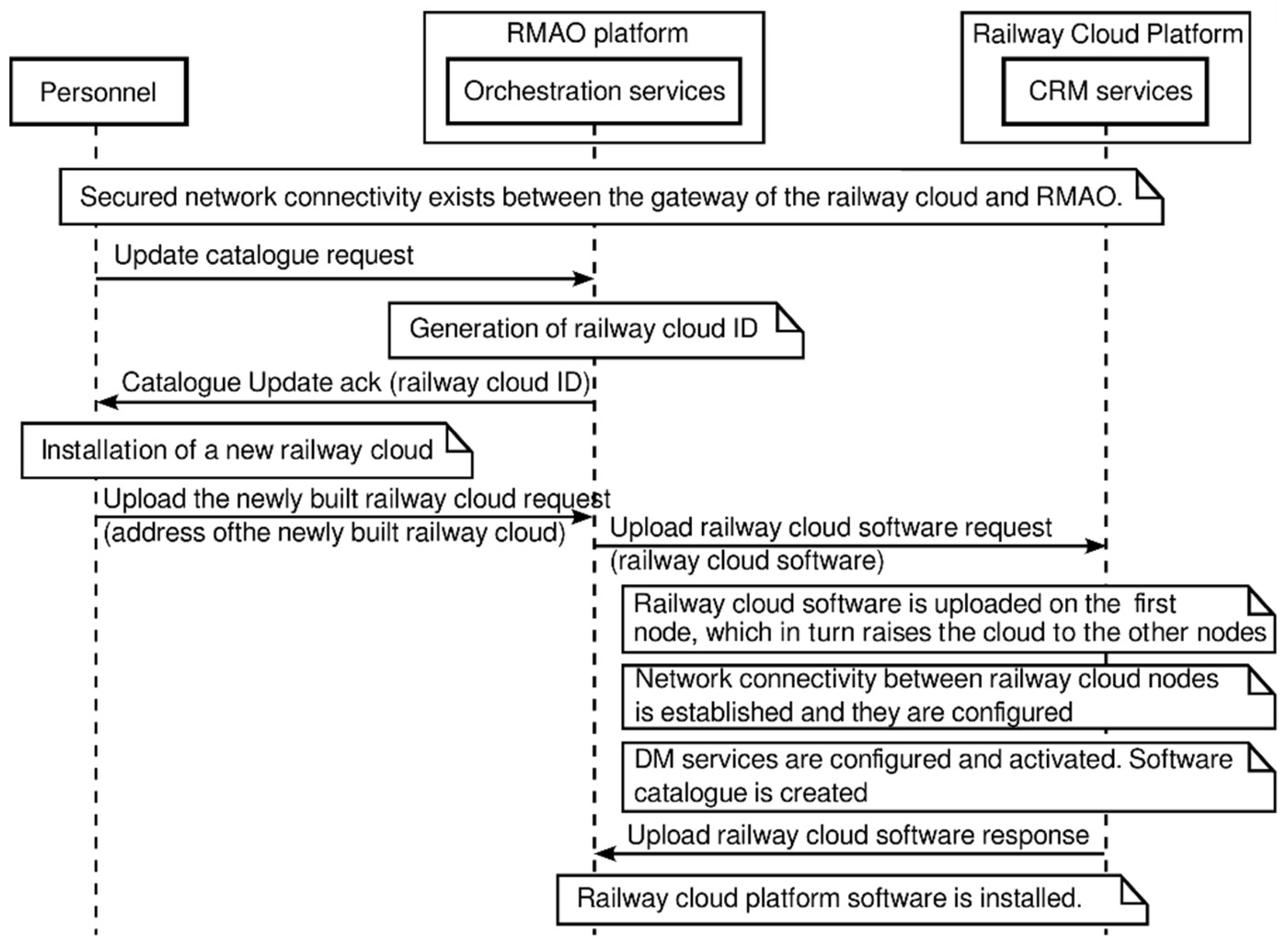
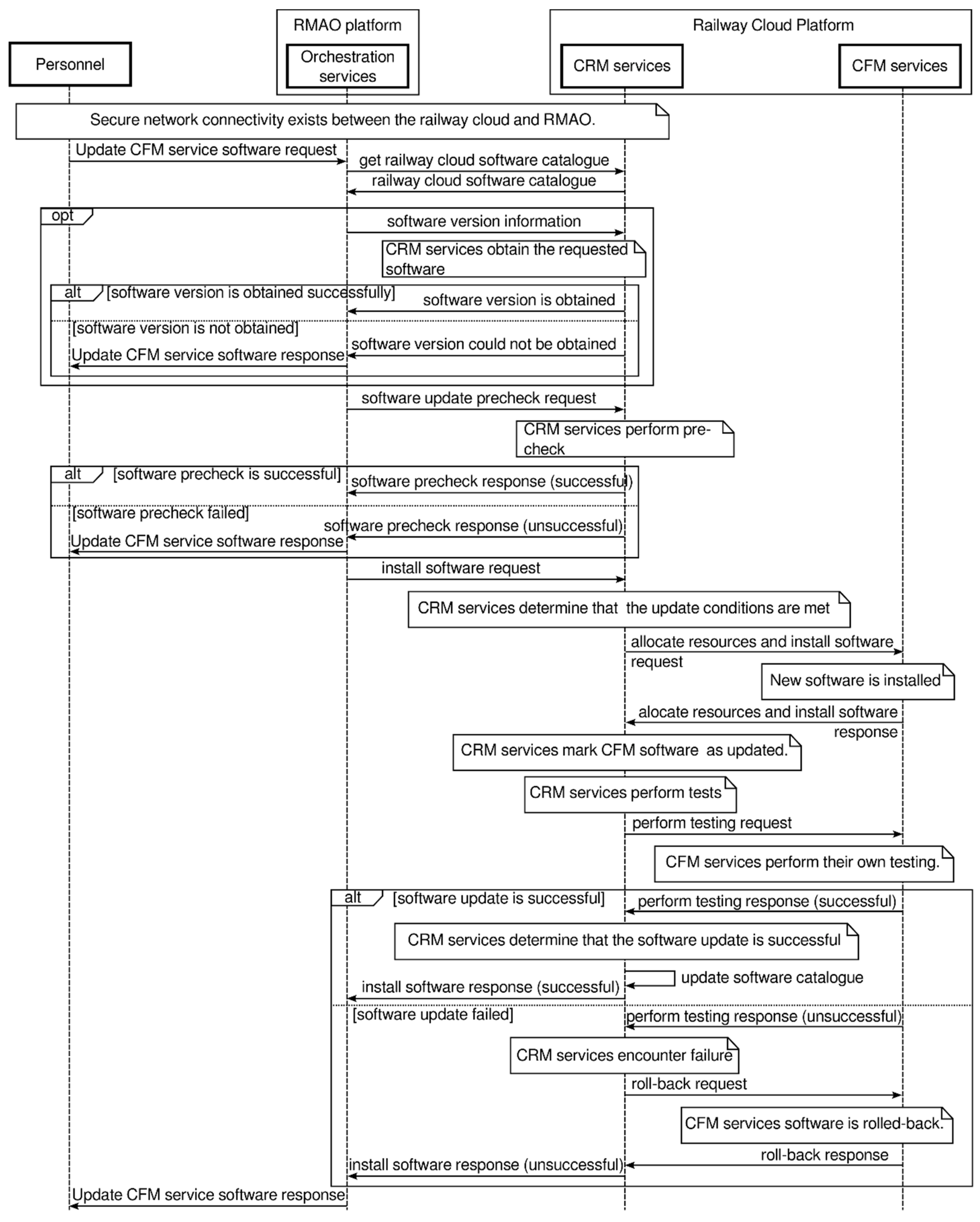
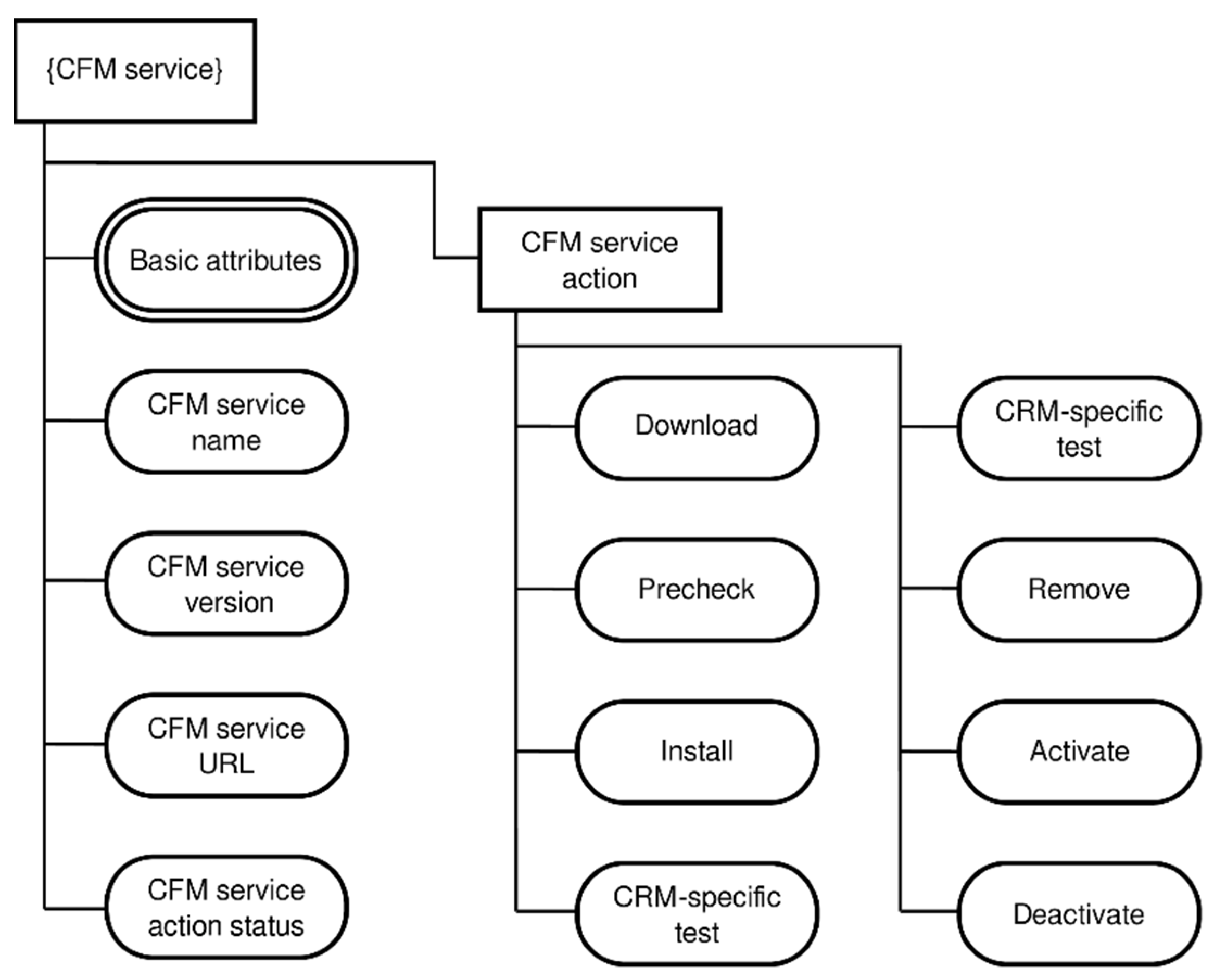

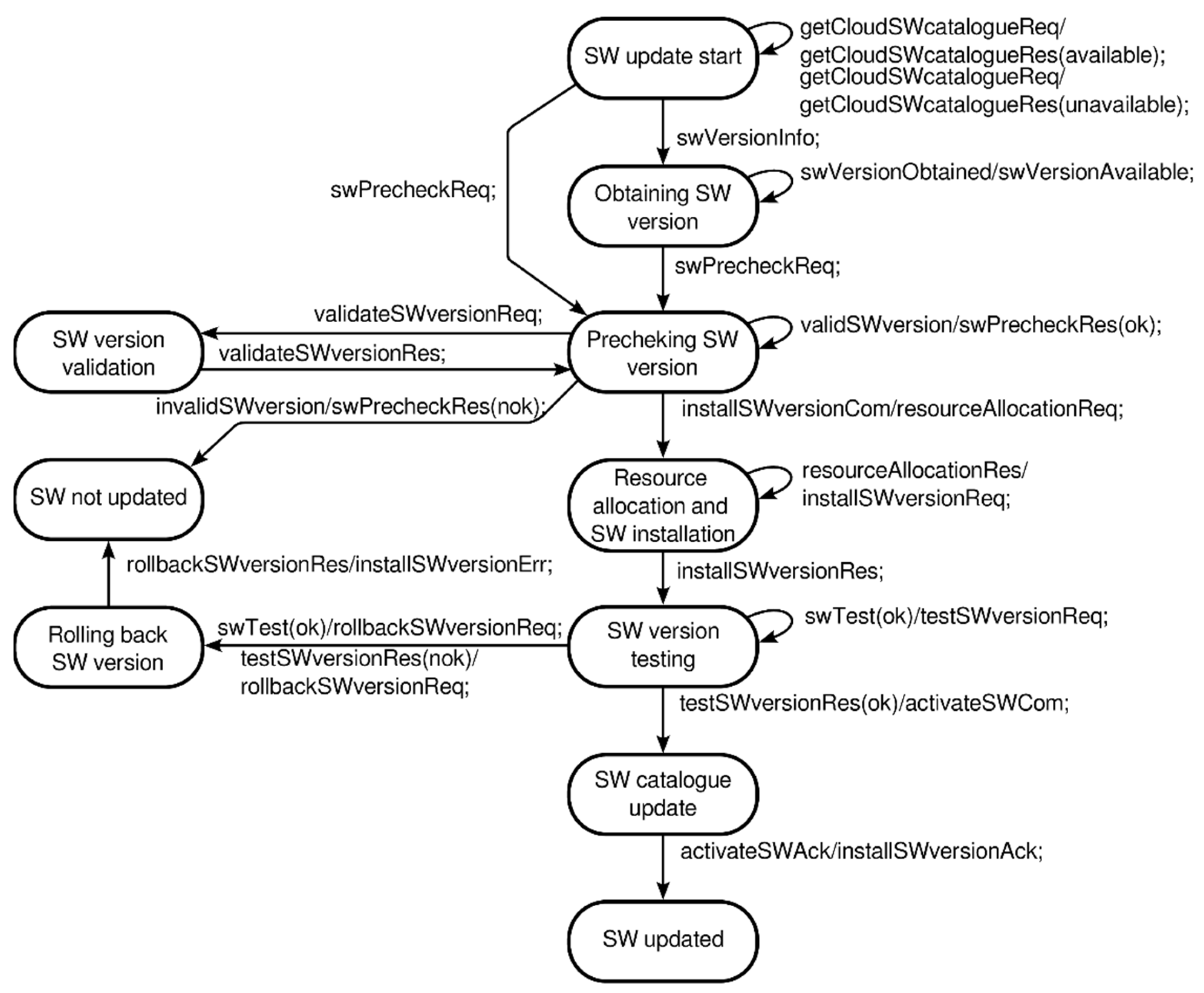

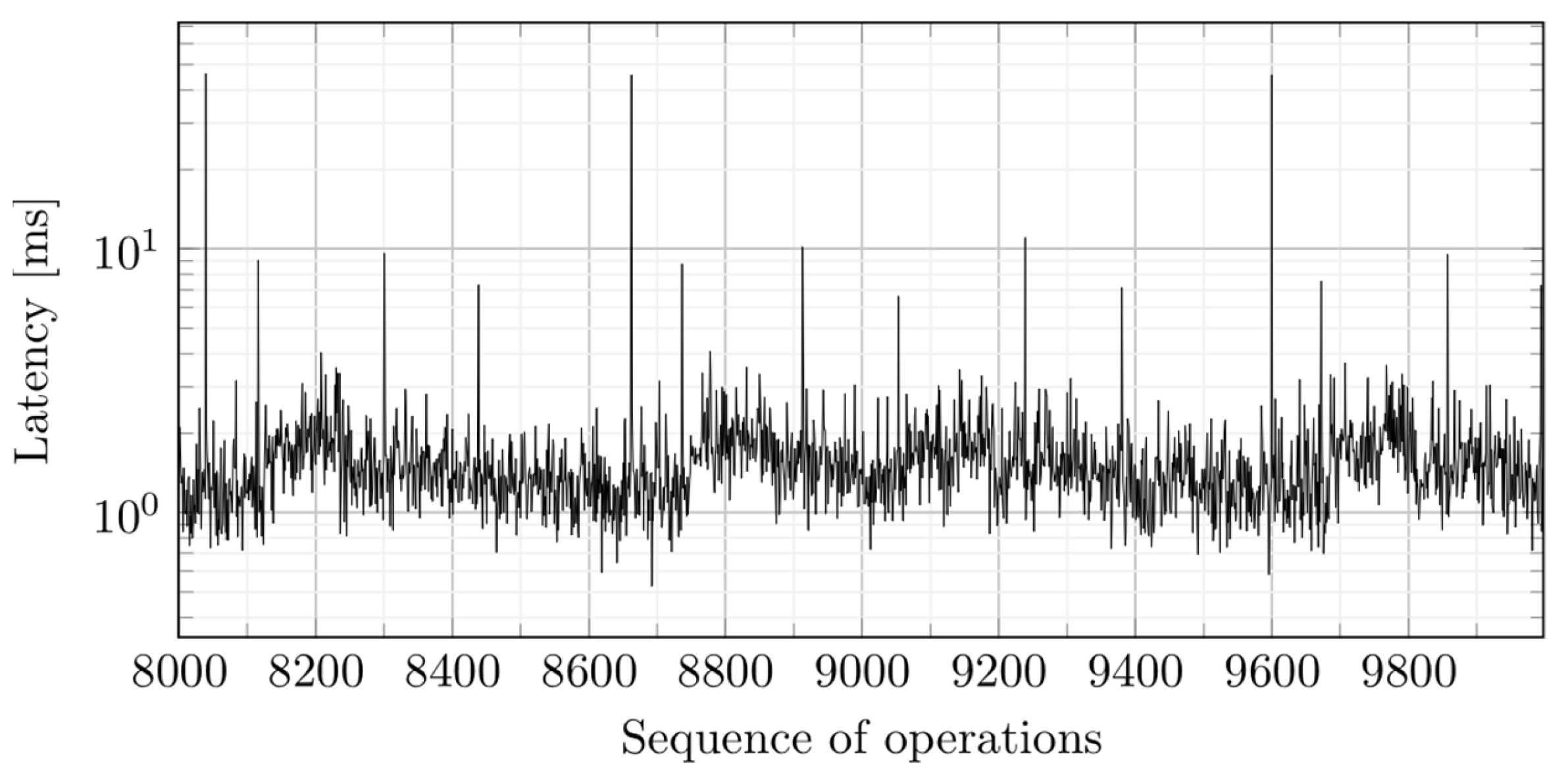
| Area | References | Considered Problems |
|---|---|---|
| Railway edge clouds | [26,27,28,29] | Optimization of offloading real-time control on edge clouds |
| Cloud computing platform architectures | [30,31,32,33,34,35,36] | Resilient and secure frameworks embedding AI and intelligent workflows, virtualization technologies |
| Cloud-based railway applications | [37,38,39,40,41,42,43,44,45,46,47,48,49] | Automatic train supervision, track monitoring, fault diagnostics, track surveillance, secure communications, ticketing systems |
| Cloud Management Aspects | Reference Numbers | Considered Problems |
|---|---|---|
| Multi-cloud platform management | [50,51,52] | Architectures, performance optimization, unified management |
| Cloud resource allocation | [53,54,55,56,57,58] | Principles, algorithms, performance, data recovery and backup |
| Cloud security | [59,60,61,62] | Threats, challenges, recommendations, access control methods |
| Resource Name | Resource URI | HTTP Method | Meaning |
|---|---|---|---|
| CFM service packages | …/CFMservicePackages | GET | Retrieves information about the list of available CFM service packages. |
| A specific CFM service package | …/CFMservicePackages/{CFMservicePackageID} | GET | Retrieves information about specific CFM service packages. |
| All software versions of the specific CFM service package | …/CFMservicePackages/{CFMservicePackageID}/SWversions | GET | Retrieves the list of software versions of the CFM service package. |
| POST | Creates a new software version of the CFM service package. | ||
| An individual software version | …/CFMservicePackages/{CFMservicePackageID}/SWversions/{SWversionID} | GET | Retrieves information about specific software versions of the CFM service package. |
| PUT | Updates information about the software version. | ||
| DELETE | Deletes the software version. | ||
| All CFM services in the software version | …/CFMservicePackages/{CFMservicePackageID}/SWversions/{SWversionID}/CFMservices | GET | Retrieves the list of all CFM services in the software version. |
| An individual CFM service | …/CFMservicePackages/{CFMservicePackageID}/SWversions/{SWversionID}/CFMservices/{CFMserviceID} | GET | Retrieves information about specific CFM services. |
| PUT | Updates the CFM service. | ||
| DELETE | Deletes the CFM service. |
Disclaimer/Publisher’s Note: The statements, opinions and data contained in all publications are solely those of the individual author(s) and contributor(s) and not of MDPI and/or the editor(s). MDPI and/or the editor(s) disclaim responsibility for any injury to people or property resulting from any ideas, methods, instructions or products referred to in the content. |
© 2024 by the authors. Licensee MDPI, Basel, Switzerland. This article is an open access article distributed under the terms and conditions of the Creative Commons Attribution (CC BY) license (https://creativecommons.org/licenses/by/4.0/).
Share and Cite
Atanasov, I.; Pencheva, E.; Trifonov, V.; Kassev, K. Railway Cloud: Management and Orchestration Functionality Designed as Microservices. Appl. Sci. 2024, 14, 2368. https://doi.org/10.3390/app14062368
Atanasov I, Pencheva E, Trifonov V, Kassev K. Railway Cloud: Management and Orchestration Functionality Designed as Microservices. Applied Sciences. 2024; 14(6):2368. https://doi.org/10.3390/app14062368
Chicago/Turabian StyleAtanasov, Ivaylo, Evelina Pencheva, Ventsislav Trifonov, and Kiril Kassev. 2024. "Railway Cloud: Management and Orchestration Functionality Designed as Microservices" Applied Sciences 14, no. 6: 2368. https://doi.org/10.3390/app14062368
APA StyleAtanasov, I., Pencheva, E., Trifonov, V., & Kassev, K. (2024). Railway Cloud: Management and Orchestration Functionality Designed as Microservices. Applied Sciences, 14(6), 2368. https://doi.org/10.3390/app14062368






